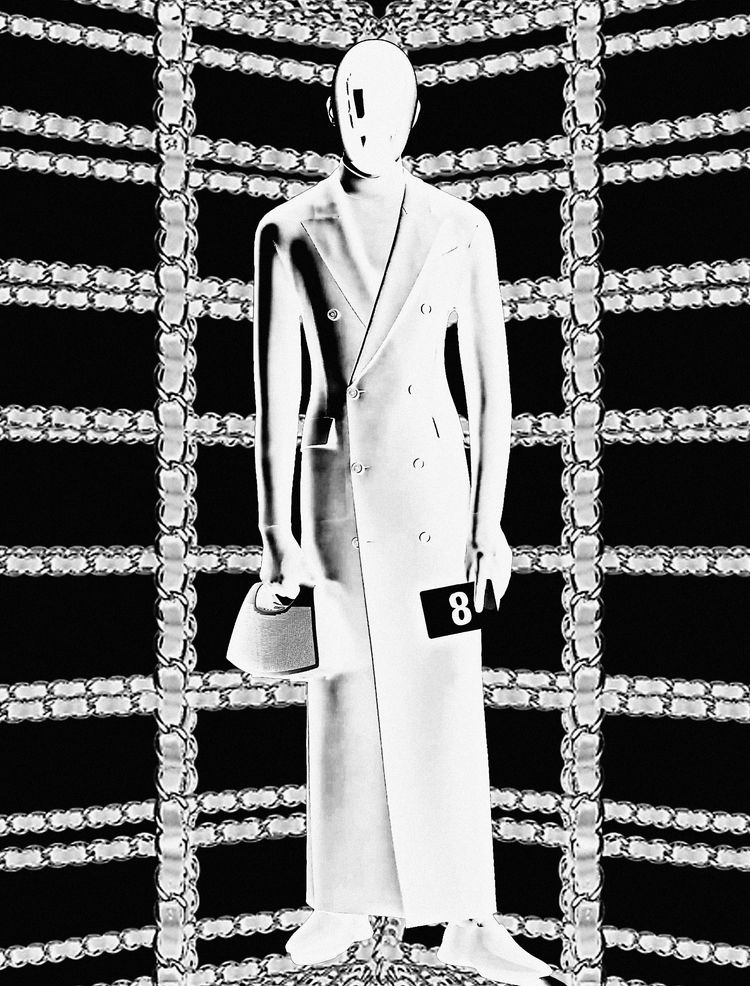Branding Beyond the Garment
Martin Margiela’s conceptual approach to fashion. Karl Lagerfeld’s Louis Vuitton punching bag. How tongue-in-cheek luxury objects became the new pop art.

The branded object has become a staple in luxury fashion, existing alongside wearable garments as a contemporary take on pop art. Balenciaga, the current leader of the conceptual product drop, presented its Couture FW22 show with Demna Gvasalia’s trademark dark, fetishistic designs on full display. One eye-catching accessory stood out amongst the rest: a jet-black Speaker Bag. Part Y2K curio, part conceptual artifact, the piece once again thrust Balenciaga into the spotlight as a luxury house continuously blurring the lines between fashion and art; the practical and the outrageous.
A look into the development of fashion-as-concept-art cannot begin without first mentioning Martin Margiela, the ur-deconstructionist whose studio was Gvasalia’s training ground once the Georgian designer graduated from the Antwerp Royal Academy of Fine Arts and moved to Paris. Inspired by the deconstructed approach of seminal Japanese designers Rei Kawakubo and Yohji Yamamoto, Margiela made a name for himself in the late ’80s with his conceptually driven garments which reimagined and disconfigured the very purpose of the items. He developed a knack for stripping a garment to its core and building it back up, reframing its language and calling into question the assumptions of luxury apparel construction and tailoring. Take the house’s porcelain waistcoat from FW89, which began as a fine porcelain tableware set, later smashed and made valueless, then brought back to life as a delicate new garment. The designer’s approach was radical, as was his impact.
Other designers and brands have explored this concept from a different yet equally cerebral angle. Jil Sander’s 2012 Vasari, for instance, took a paper bag that was essentially a lunch bag and gave it a luxury leather makeover. Minimal, ironic and produced with all the hallmarks of fine Italian craftsmanship, the object invited analysis, obsession and criticism. Two years later, Louis Vuitton reimagined its iconic monogram with the release of six objects at the intersection of fashion, art and design. Perhaps the most memorable is the Karl Lagerfeld-designed punching bag. The object, produced in a run of 25, transcended practicality and is among the most desired fashion-art items of all time.
That same year, Chanel sent Cara Delevingne down the runway against the backdrop of a candy-hued supermarket. The accessory of the day was a $12,500 shopping basket complete with classic Chanel chain links. Merging the everyday with biting humor and classic Lagerfeld-tinged luxury, the show, as Tim Blanks suggested, “skewered the art world for the oligarchs’ supermarket it had turned into.” Editors fought over the branded objects as soon as the show ended, charging onto the set and stealing Chanel onions and doormats. Their reactions made it clear that along with the items’ quirkiness came genuine demand. Chanel FW14 was a sharp yet affectionate performance-art statement on contemporary materialism and our relationship to luxury. The shopping basket—more than the chaos tied to it—was a lasting object of this conceptual critique. This was the new era of pop art.
In 2016, Supreme gave us a box logo-branded red brick as a part of the label’s FW16 collection. A sardonic reference to the oft-repeated claim that Supreme could sell anything, the brick was as tongue-in-cheek as it was validating. It was the next product evolution for a label that was already the master of releasing branded objects skating on the grey area between art and function. From decks made in collaboration with blue-chip artists to 2015’s Warholian fire extinguisher and ashtrays, the NYC brand had long toyed with the status and significance of its products. The brick was preposterous; it also pushed the cultural conversation around conceptual absurdity to new heights.
A year after Supreme’s brick hit the market, Raf Simons dropped duct tape reading “Youth Project”' in minimal red block lettering against crisp white polyurethane, serving both as a collectable and a DIY-styling object. That same year, Prada released a sterling silver paper clip-shaped money clip, generating the ire of fashion critics while straddling the line between the elegant and the risible.
These objects represent a shift in fashion’s relationship to product development, leading to a new consideration of fashion as art. Just as designers have gradually released more and more conceptual objects, the art world has increasingly taken fashion into its fold. Whether it’s Sotheby’s auctioning off the earliest Air Jordans that Michael Jordan wore on the court or museum exhibitions focusing solely on designers—from The Met’s groundbreaking Alexander McQueen show to the Brooklyn Museum’s Virgil Abloh exhibition—the parallels between art and fashion are becoming more and more evident. Many designers are even cutting out the “concept” angle altogether, collaborating with fine artists directly (see: Virgil Abloh and Takashi Murakami and Marc Jacobs at Louis Vuitton with Richard Prince). Other designers have left fashion completely to focus solely on fine art; Martin Margiela and Helmut Lang stand out as among the most well-known.
We’ve reached a space where fashion is no longer restricted to garments. Just as you can collect Yeezys or Air Jordans as design objects stripped of their functional value, certain fashion items have taken on a layer of cultural and pop art relevance. Balenciaga’s Speaker Bag is only the latest in an evolving approach to deconstruction in fashion and cultural criticism. The envelope is being pushed by the day, and the role of the brand is evolving with each and every drop.